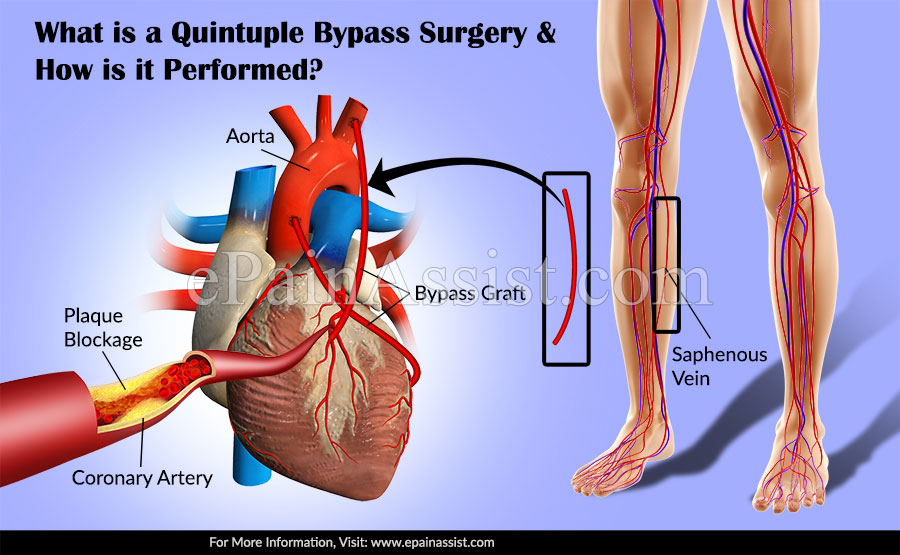What is a Quintuple Bypass Surgery?
A quintuple bypass surgery is a medical operation which one has to undergo in order to treat severely blocked coronary arteries unable to supply oxygenated blood to the heart muscles. In case of quintuple bypass surgery, all the five major arteries which are blocked have to be treated. Hence, the quintuple bypass surgery will take quite a bit of time to be successfully completed and requires several grafts of arteries and veins.

How Long Does It Take For A Quintuple Bypass Surgery To Be Done?
The quintuple bypass surgery is a pretty serious one. Since quintuple bypass surgery is an open heart surgery, it may take a considerable amount of time to be done. Although the technical part of the procedure which includes sewing new blood vessels to the heart takes around an hour to be done, the entire quintuple bypass surgery takes around three to four hours. It includes the preparation time, opening the patient’s breastbone, taking the blood vessels from other body parts and grafting them. Lastly, the surgeons have to make sure that everything is closed up properly at the end of the procedure.
How to Get Ready For A Quintuple Bypass Surgery?
Quintuple bypass type of surgeries is scheduled well in advance. Patient has to undergo few pre-surgery testing to determine if the patient’s health will be ready to take such a massive operation. During the wait for the quintuple bypass surgery, the patient has to switch to eating excessively heart-healthy diet, control cholesterol and blood pressure and blood sugar levels and quit smoking. These measures improve the final outcome of the surgery and reduce the risks associated with the surgery.
How is the Quintuple Bypass Surgery Performed?
- Quintuple bypass surgery needs open heart surgeries to be performed; the patients have to be operated under general anaesthesia.
- Blood vessels are taken from other parts of the body to be grafted onto the existing heart vessels surrounding the blockage.
- It should be remembered that a quintuple bypass surgery requires more blood vessels than any other procedure. Thus, multiple blood vessels have to be taken from various sites.
- Once the sufficient blood vessels are taken from various points, the chest has to be opened. Following this, the sternum, commonly called the breastbone, has to be divided in half so that the surgeon to access the heart.
- The whole quintuple bypass surgery procedure is performed while a special type of machine called the cardio-pulmonary machine does the functions of the heart and lungs. This allows the surgeons to stop the heart and perform the surgery without the constant movement of the heart beating.
What are the Benefits of Undergoing Quintuple Bypass Surgery?
The first and foremost benefit of undergoing the quintuple bypass surgery is an improved quality of life. When a patient is recommended for quintuple bypass surgery it means that all of the major five arteries are deceased. Delay of treatment for such situations can bring fatal risks to reality. This is because the diseased arteries cannot provide oxygen-rich blood to the heart muscles. Due to this, risks of stroke or heart attack naturally increase. Undergoing the quintuple bypass surgery provides a pathway for the blood supply to the heart muscles. This improves the functioning of the patient’s body. It should be noted that in order to gain the maximum benefit from the quintuple bypass surgery, few lifestyle changes after the surgery are mandatory. These include keeping oneself fit. Patients have to undergo heart rehabilitation therapy after a quintuple bypass surgery. This simply includes practicing some exercises under a professional therapist. The patient, after quintuple bypass surgery recovery, has to continue physical exercise in order to stay fit and healthy. A balanced diet is also advised.
Also Read:
- Bypass Surgery Recovery Period & What to Expect After Bypass Surgery
- Do’s and Don’ts Following Bypass Surgery
- Precautions after Bypass Surgery, Know the Do’s & Don’ts after Bypass Surgery
- Diet after Bypass Surgery|Foods to Take & Foods to Avoid After Bypass Surgery
- Gastric Bypass Surgery- Why Is It Needed? Advantages & Disadvantages of Gastric Bypass Surgery
- Pre & Post Gastric Bypass Diet|Foods to Eat & Foods to Avoid after Gastric Bypass Surgery
- How Serious is a Triple Bypass Surgery?
